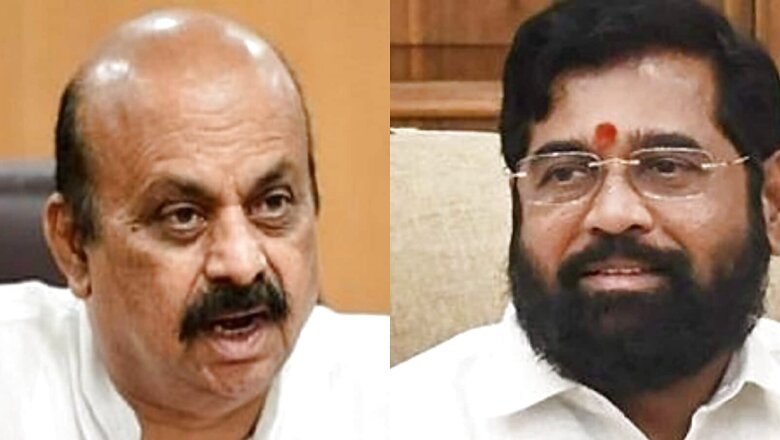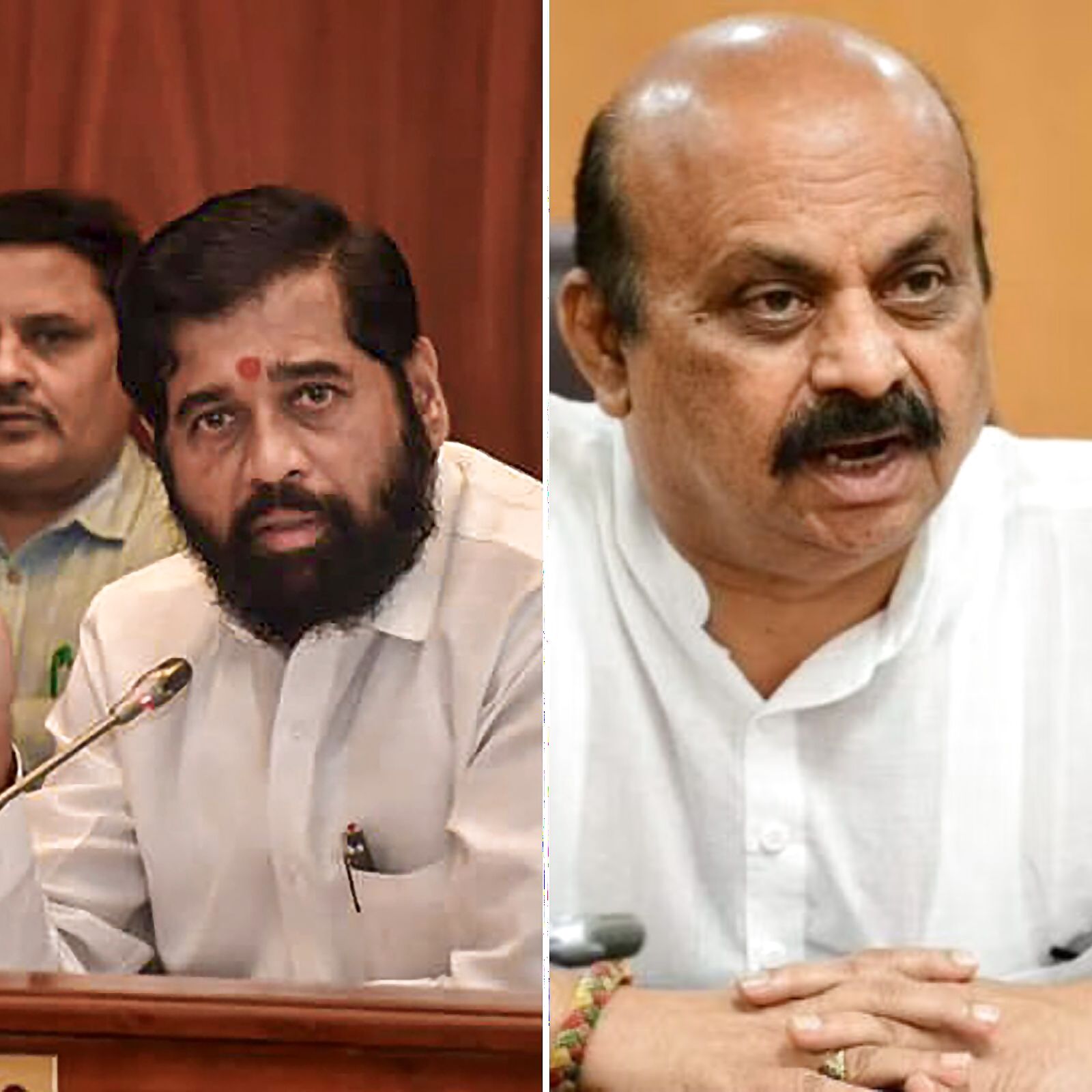
views
In the latest development on the escalating border row between Maharashtra and Karnataka, Chief Minister Eknath Shinde and his counterpart Basavaraj Bommai held a telephonic conversation to work towards its resolution. READ MORE
After the phone call, Bommai took to Twitter and assured of both leaders having agreed to “maintain peace and law and order.” However, he said his stand on the border matter ‘still remains the same’, and that it will be pursued in the Supreme Court.

Peace prevailed in Belagavi on Wednesday and other parts of this district, a day after pro-Kannada organisations held a protest on the border row that affected normal life. The protests were held against the proposed visit of two Maharashtra ministers on Tuesday here amid the ongoing border dispute, PTI reported.
But what is the issue, and its genesis? News18 explains:
What’s Happening on the Latest Front?
Maharashtra ministers Chandrakant Patil and Shambhuraj Desai, appointed for coordinating the state’s border dispute with Karnataka, were slated to visit Belagavi district earlier, but the tour did not materialise, leading to angry reaction from Opposition parties who dubbed them as “cowards”.
The two ministers were scheduled to meet activists of the Maharashtra Ekikaran Samiti (MES) at Belagavi in Karnataka and hold talks with them on the decades-old border issue. MES is an organisation fighting for the merger of Belagavi and some other border areas with Maharashtra.
The development came a day after Bommai said he will ask his Maharashtra counterpart Eknath Shinde to not to depute his cabinet colleagues — Patil and Desai — to Belagavi as planned citing law and order, even as prohibitory orders were clamped in the border district ahead of the proposed visit of the delegation.
We officially informed Karnataka Govt that 2 of our ministers are going to Belagavi but Karnataka govt said that if we go there, law & order situation can arise in Belagavi. We decided to postpone this,we haven't cancelled our visit: Shambhuraj Desai, Maharashtra Cabinet Minister pic.twitter.com/yVlFBli4Jq— ANI (@ANI) December 6, 2022
Maharashtra State Transport Corporation (MSRTC) on Tuesday afternoon suspended bus services to Karnataka citing a police advisory, a top official said. MSRTC Vice-Chairman and Managing Director Shekhar Channe told PTI the decision was taken considering the safety of passengers travelling to Karnataka and to avoid damage to their property.
Maharashtra Deputy Chief Minister Fadnavis spoke to Karnataka Chief Minister Bommai over stone pelting on vehicles from Maharashtra entering the southern state and said he will also take up the matter with the Centre. He blamed Karnataka for creating needless controversy over the border row after the Maharashtra government last month appointed two ministers to coordinate with the legal team regarding the court case on the decades-old boundary dispute between the two states.
In the backdrop of rising tension between the two states over the border row, a video surfaced on social media showing some people throwing stones at vehicles entering Karnataka from Maharashtra near a toll booth at Hirebaugwadi in Belagavi district of the adjoining state.
Sources close to the Maharashtra Deputy CM said, “Fadnavis made a phone call to Karnataka Chief Minister Basavaraj Bommai and expressed his disappointment over the Hirebaugwadi incident.” “The Karnataka Chief Minister assured Fadnavis of strong action against the perpetrators. He also assured Fadnavis that vehicles entering Karnataka from Maharashtra will be given proper protection,” the sources said.
Speaking to reporters later in the day, Fadnavis said, “I am going to inform Union Home Minister Amit Shah about today’s incident as well. It is not a good thing if such incidents keep taking place between the two states.” The deputy CM, who also handles the home portfolio, said the Constitution allows free movement of people in the country.
“The Constitution has empowered everyone to travel from one state to another, start a business or to live anywhere. If this fundamental right is being trampled upon, then the state in question should stop such incidents,” he said.
In Bengaluru, Karnataka Chief Minister Bommai tweeted about his conversation with his Maharashtra counterpart Shinde, but asserted there was no change in his state’s stand as far as the border issue is concerned.
“Maharashtra Chief Minister Shri Eknath Shinde had a telephonic discussion with me, we both agreed that there should be peace and law and order to be maintained in both the states,” Bommai said in the tweet.
Noting that there are harmonious relations between the people of both the states, he said, “however there is no change in our stand as far as Karnataka border is concerned. And the legal battle will be pursued in the Supreme Court.” In Mumbai, the Eknath Shinde-Bharatiya Janata Party (BJP) government faced the Opposition fire over Maharashtra ministers Patil and Desai not visiting Belagavi as planned earlier.
What’s the Border Row?
The border issue dates back to 1957 after the reorganisation of states on linguistic lines.
Maharashtra laid claim to Belagavi, which was part of the erstwhile Bombay Presidency as it has a sizable Marathi-speaking population. It also laid claim to 814 Marathi-speaking villages which are currently part of the southern state. Karnataka, however, considers the demarcation done on linguistic lines as per the States Reorganisation Act and the 1967 Mahajan Commission Report as final.
Belgaum was originally part of the multilingual Bombay Presidency. Districts in Karnataka such as Vijayapura, Belagavi, Dharwad, and Uttara Kannada were previously part of the Bombay Presidency. Belgaum became a part of Bombay State after India’s independence in 1947. According to the 1881 census, 64.39 percent of people in Belgaum spoke Kannada, while 26.04 percent spoke Marathi.
However, in the 1940s, Marathi-speaking politicians dominated Belgaum and requested that the district be included in the proposed Samyukta Maharashtra state.
Despite their protests, the States Reorganisation Act of 1956 incorporated Belgaum and ten talukas from Bombay State into the then Mysore State, which was renamed Karnataka in 1973. The Act divided states along linguistic and administrative lines.
THE MAHAJAN COMMISSION REPORT
The Bombay government filed a protest with the Centre, which resulted in the formation of the Mahajan Commission in 1966, led by former Chief Justice Mehr Chand Mahajan.
In its 1967 report, the Commission granted Maharashtra 264 villages in the disputed region and Karnataka 247 villages. However, the commission decided that the Belgaum should remain in Karnataka. While Maharashtra rejected the report, Karnataka demanded status quo.
The Maharashtra government filed a petition in the Supreme Court in 2006, claiming ownership of Belgaum. According to the state government, there has been a “feeling of insecurity among the Marathi speaking people living in Karnataka in recent days.” Meanwhile, the Belgaum district, as well as the city of Belgaum, remain a part of Karnataka.
THE WINTER GAME
Every time the Karnataka Assembly session is held in Belagavi, tensions crop up between the states. In 2021, during the Belagavi session, an MES activist’s face was blackened by Kannada activists for organising an event demanding the merger of Belagavi with Maharashtra. Days later, the statue of freedom fighter and Kannada icon Sangolli Rayanna in Belagavi city was vandalised, Indian Express reported.
THE STATES REORGANISATION ACT
The States Reorganisation Act, 1956, reformed the boundaries of Indian states and territories, systematising them on the basis of language. The newly drafted Constitution of India, which came into force on January 26, 1950, divided states into four main types: Part A, Part B, Part C, and Part D.
Part A states were former governors’ provinces of British India, while Part B were former princely states or groups of princely states. Part C states comprised both the former chief commissioners’ provinces and some princely states and Part D was administered by a lieutenant governor appointed by the central government.
At the time of Independence in 1947, India had more than 500 disjointed princely states that were temporarily divided into Part A, B, C, and D states. The State Reorganisation Commission was constituted on December 29, 1953, to look into redrawing state boundaries, mainly on the basis of languages, to make administration easier and replace caste and religion-based identities with the less-controversial linguistic identities.
With inputs from PTI
Read all the Latest Explainers here




















Comments
0 comment